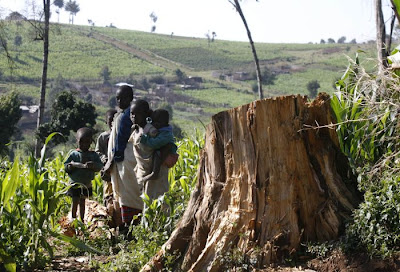Following her critically acclaimed film From a Whisper, Kenya’s multi-award winning director is back with a new film, Pumzi. In an interview African Screens’ Don Omope speaks with Wanuri Kahiu about her new film, her quest to engage more with her Pan-Africanness. Read more here
 |
Director of Pumzi, Wanuri Kahiu (R) and lead actress, Kundzani Moswela on setWas Pumzi a conscious decision on your part to shoot a sci-fi film or was this necessitated by the script you had in hand?I never actually had an interest in Sci-fi, Pumzi was written in two years and was a combination of many different conversations I had with people around me. The first conversation was about a world were you had to buy fresh air. Another conversation was about the need for a virtual museum, a museum of virtual natural history were we will have stimulated images of nature because our relationship with our environment is not sustainable. It was a series of different conversations with different people that came together as Pumzi. There are subtle similarities between the 1976 film Logan’s Run and Pumzi, were you familiar with the works of film director Michael Anderson? I have heard of the film by Michael Anderson but have never seen it, I tend to get a lot questions saying sci-fi isn’t an African film genre, so when I was creating this film I stayed away from watching sci-fi films not to be influenced wrongly by such films because I wanted this sci-fi to be a uniquely African experience. How did you go about researching your film? I knew specifically what I wanted to achieve and I watched fantasy films to see how their sets are built because they have beautiful sets. When I write I do visual research at the same time. I believe in sharing my ideas, so when I write I speak to people around me, telling them this is the idea I am doing and they are usually very resourceful, sharing ideas with me and pointing me in directions of things I might not have been aware of, but are very useful to the formation of my idea. You have come a long way from your university film ‘Ama’s Mama’, then you shot ‘Ras Star’ and went on to direct the multi-award wining ‘From a whisper’ and now we have ‘Pumzi’ - what would you say is your approach and perhaps philosophy as a visual story teller? This is very tied in with my identity; I have to chose very carefully which type of films I make, because it’s very difficult to make films in this part of the world. I have to be very careful about our representation of Africa because there are many old stereotypes still around, we have to show a different image of Africa, a new Africa people can relate to, I don’t see this as a choice I see it as mandatory. We show an image Africans can identify with; stylistically sometimes my films choose me I don’t choose them. And within these films I have to find a permanence that resonates with me, and one thing I continue to work with is the idea of belonging… and this resonates across my films. I use my experience to explain the experiences of others and I feel more often than not we Africans are often looking for a sense of identity, belonging, a sense of place. Pumzi questioned our relationships with our environment, are you an environmentalist and if you are, is there any issue close to your heart? Yes I am an environmentalist; I think that anybody who says he or she is not is really denying. Our relationship with water and things related to water is close to my heart and that’s part of the reason I wrote Pumzi. I don’t like bottled water because it takes more water to make bottle water. Pumzi is my anger, my anger about the way we continue to live as people. What qualities must a story satisfy to be of interest to you as a filmmaker? I have a very particular interest and a resolute one too. I must say in strong female characters, and this has becomes more and more important for me everyday. Also my stories need to take personalities out of the norm, be it emotionally or otherwise, I am drawn to good stories and the possibilities of a good story, because a good story always sells irrespective of location or geography. A trend I have noticed in your films, is the use of very strong female lead characters, (using Ras Star as a case in point) are your films mirrored on your experiences of everyday life in Kenya and the role women play? There is this curiosity that comes out when people ask me what it is like to be a female filmmaker? I don’t know I have never been a man. This is the most natural place for me to write from, following closely on that, when I write female characters I see more and more the need for them, case in question, Nina Simone. This was an emotionally devastating story for me as a woman; and I feel it is the duty of any female filmmaker to champion the writing of robust female characters that are challenging, and not the stereotypical depictions of female characters being very maternal, motherly type characters, or beautiful women weather attainable or not attainable, there is more to the female character than that. Which African filmmakers have inspired your film-making and are there other African filmmakers whose work you have found to be of interest? Recently I am interested in people of my generation like Caroline from Uganda, she shot the nice film Imani, but also the older generation, Ousman Sembene, Oumar Sissoko, Harooun etc. But I grew up on a literary background so my main influence have come from writers, like Chinua Achebe, Ben Okri. What new thing have you found out recently that as being of interest to you? As a result of Pumzi, travelling has become dear and close to my heart, I discovered the idea of my pan-africanness, what it means to be pan-African in modern Africa, and one of the things I want to do is to travel more across the continent and learn about my pan-africaness. Reviewing the film, Pumzi by Wanuri Kahiu |















